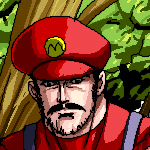|
A crying skull. No attacks or anything, it's just really sad.
|
|
|
|

|
| # ? Jun 11, 2024 21:02 |
|
sebmojo posted:A crying skull. No attacks or anything, it's just really sad. Its guarding a treasure, making it not sad will clear the path. Doing a favor, telling a joke, etc...
|
|
|
|
Dameius posted:Its guarding a treasure, making it not sad will clear the path. Doing a favor, telling a joke, etc... Smashing it will make the smasher sad
|
|
|
|
I am extremely in favor of goofy skeletons in games and support you and everything you do, spiritually.
|
|
|
|
I'm sure I've mentioned this idea before in this thread but: on the way to the mine the party encounter a ragged-looking peasant running the other way, pursued by like twelve skeletons. He trips, the skeletons catch up with him, and take up defensive positions around him, with one of them playing a jaunty but repetitive song on the accordion (find a ten second music sample of Pop Goes The Weasel or something and play it on loop during the encounter) and another dancing a merry jig. They've been following him and doing this for the past week with no signs of stopping and they attack anyone who comes near him. He doesn't know why, and he's having to survive by scavenging berries because he gets driven out of any settlement he goes near. E: or even better, Turkey in the Straw Whybird fucked around with this message at 23:45 on Feb 11, 2020 |
|
|
|
I'm runnin a game tonight where they are tracking down three skeleton sisters who heisted a mcguffin from them definitely cribbing from this thread to spice up the Tres Bone-itas
|
|
|
|
There's a crystal skull that will attack them with a radioactive refrigerator.
|
|
|
|
How good is your Skeletor impersonation? Because what I'm saying here is, every single skeleton they fight is Skeletor. Not like, statted up or anything, just constantly talking in that weird voice, calling the other skeletons fools/simpletons/dolts, cursing the the party when they get disassembled, etc. Have skeletons team up Mecha Shiva style. Skeletons armed with skull-head maces that bash you and then bite you. A tunnel that dips underwater for a short section, with skeletons hiding in the darkness. They're armed with fishing rods/nets and are wearing fly fishing hats and waders, and attempt to hook the party members as they swim past. One single flesh golem that came to the mines to become a real boy but keeps accidentally "killing" the skeletons he's trying to, uh, wear.
|
|
|
|
A giant pile of bones that has a bunch of skeletons raving and dancing on top of it. They ignore the players if they are ignored, and if the players attack them they're narcs.
|
|
|
|
An evil skeleton that, in life, was a surgeon. He has been amusing himself in undeath by disassembling other skeletons and reassembling them into inhuman configurations, so you get poo poo like a bunch of skeletons all grafted into one super-long snaky-centipede-y thing with all the heads at the 'front' His name is Doctor Skellington and he is very cross about it EDIT: he is constantly accompanied by a multi-armed skeleton that is constantly playing music on an ambulatory bone xylophone, because he wanted his own theme music
|
|
|
|
Some sort of magical item that only activates when the person wielding it makes a skeleton pun. Naturally it's encountered by a user that makes absolutely terrible puns every turn. You're going to have to write quite a few of these down to prepare.
|
|
|
|
Morpheus posted:Some sort of magical item that only activates when the person wielding it makes a skeleton pun.
|
|
|
|
A pair of bone maracas that, when shaken, cause 2d6 skeletons to rise from the ground and begin a traditional Dia de los Muertos celebration no one knows where the skeletal mariachi band gets the brass instruments from this effect is useless in combat, as the skeletons do not appear in the presence of violence; they are there to have a good time, not watch people get stabbed
|
|
|
|
a necromancer has figured out how to animate skeletons while they are still inside alive people but uses it to set up a fighters' school, teaching legwork and technique through physical rote, churning out highly skilled fighters very quickly, but unwittingly subject at any time to full skeletal control by the necromancer, who is slowly building an army that will go out and equip itself the party is tipped off to this by a fighter who has figured it out but is regarded as having a weird conspiracy theory by his peers, since the necromancer is posing as some kinda telekinesis savant
|
|
|
|
Peanut Butler posted:a necromancer has figured out how to animate skeletons while they are still inside alive people but uses it to set up a fighters' school, teaching legwork and technique through physical rote, churning out highly skilled fighters very quickly, but unwittingly subject at any time to full skeletal control by the necromancer, who is slowly building an army that will go out and equip itself That... sounds like it would be the actual plot of a published adventure.
|
|
|
|
Got a big old list now, thanks everyone. To be honest, I'll probably not need them - they're going to spend at least an hour arguing about the "you find a perfect & delicious looking shiny red apple in the middle of the floor" event.
|
|
|
|
Sanford posted:Got a big old list now, thanks everyone. To be honest, I'll probably not need them - they're going to spend at least an hour arguing about the "you find a perfect & delicious looking shiny red apple in the middle of the floor" event. if they eat it, it's really tasty
|
|
|
|
sebmojo posted:if they eat it, it's really tasty And it makes them feel full. But not too full.
|
|
|
|
So like, I'm trying to get in to GMing and I have ideas for plot threads and such, "Hey every so many years this town has a hunt for a white boar and you're in town for the celebration, the white boar turns out to be an elite boar that guards a local forest temple containing a historical relic" "A necromancer invades a local crypt to summon an old champion from their younger years, however in death he retains his intelligence and turns on the necromancer forcing them to summon more and more and more skeletons causing an army threat, party must go in and kill the skeletonchampion again, and save/kill the necromancer" "A young boy in town is selling papers, and implores the party to purchase for important reasons, the boy's family is being held kidnapped and if they don't make enough money selling papers then his family will be forced into a press gang" The problem is getting into the nuance of it or where that leads. How big should the crypt be. How many enemies should be in the crypt. What level should they be. What should the dungeon look like. Similarly, larger plots than just 1 episode things I can't figure out how to do. I'm using pathfinder 2 and the gm guide is coming out shortly so I hope that will have some tips in it but I've been told I don't give enough details for surroundings and don't give threads to follow in a nice way and I don't know how to get better at that. Is there any books that people would suggest?
|
|
|
|
Forer posted:So like, I'm trying to get in to GMing and I have ideas for plot threads and such, I try to think of why the dungeon exists, and why the monsters that are there are there. Is the goblin lair a natural cave they found, or have they stumbled into an ancient tomb and are only living in part of it? Both will have goblins, obviously, but the first might also have some wandering underdark creatures, where the second might have undead (and undiscovered treasure) deeper in the tomb where the goblins have been too scared to go. PF2E has had very good math for building encounters in the little bit I’ve played it, so that part at least is relatively easy-just pick monsters that sort of fit your theme and come up for a reason they are in this dark dungeon and not anywhere else. Once you have some motivation for them, it can make encounters more interesting too. The PCs meet a party of drow searching for the treasure buried deeper in the tomb. Are the drow willing to fight to the death for the treasure, or are they just as likely to cut and run if they meet a party of tough PCs when they were expecting only some goblins and undead? Maybe they’re willing to make a deal with the PCs and work together to get through the tomb, but each group is trying to let the other do the brunt of the fighting to save their resources in case the other turns on them. In my experience, thinking about the why for dungeons (and NPCs) helps lend some feeling of verisimilitude to the game. Obviously it’s fantasy and we don’t expect realism, but it feels more natural if the players can see why the things they are fighting are here and that those things have goals of their own they are trying to accomplish.
|
|
|
|
Forer posted:I've been told I don't give enough details for surroundings and don't give threads to follow in a nice way and I don't know how to get better at that. Is there any books that people would suggest? It sounds a lot like you're writing by thinking of things for your PCs to do (hunt a wild boar) and then coming up with surroundings that draw them into that (the local town has a boar hunting festival). There's nothing wrong with this but the approach I prefer is to do it the other way round: I figure out what the world is like, from that I work out what kind of tensions exist, and from there I figure out what kind of problems are likely to arise that a small group of highly-armed idiots might be paid to solve. For example: a while back my PCs rocked up in a new village that I decided would be a very tightly-knit, religious, Puritanical community. From there I thought what kind of tensions that would create, and came up with: - A farmer has struck gold and wants to sell his land to wealthy outsiders rather than sharing with the community - The inn is supposed only to sell alcohol to outsiders, not to the townsfolk, but some of the townsfolk are buying it illicitly - Other faiths are persecuted within the village Then from there I came up with a few ways they could become problems that the PCs could solve: - The farmer hires mercenaries to stop the townsfolk driving him from his land; the townsfolk offer to pay the PCs to do their dirty work for them - The bartender's shipments keep getting attacked by what he assumes are religious vigilantes, and he pays the PCs to travel with a shipment and unmask them - Visitors who are members of another faith ask the PCs to break one of their number, who has been arrested on religious charges, out of jail. At that point, you're still presenting the PCs with adventurer-shaped problems, but now because you've started with the situation that brought them into existence they feel like an organic development of an existing world. Plus, you're now much better placed to roll with the punches if the PCs decide to solve it in a completely different way or take the other side.
|
|
|
|
In my opinion, DM 101 is don't revolve the world around the players, have the plays fit into the world. The dungeon wasn't built a hundred years ago to test your party when they showed up. It has a purpose, every room has a specific reason why it exists (carving rooms out of earth 20ft underground is hard work! You don't do it for fun), every person/monster who lives there has an essential job (the evil dungeon lord doesn't pay henchmen to just sit around and wait for heroes to show up, he has to maximise his limited resources for evildoing). Even a horde of dungeon dwelling Goblin soldiers need sleeping quarters, a kitchen to feed them all, a mess hall to eat in, armoury (they aren't lugging their shields and spears around all the time), sick ward of some kind for the injured and so on. Even the location of the dungeon, why is it where it is? Great transport links? Hot spring at the bottom to provide a source of heat/energy? Magical ore they are mining? You don't need to go the full extreme of outlining every single encounter this way, but for big setpieces or locations you will spend multiple sessions in it can really add versimilitide. As for leading players through a story, a golden rule is The Three Clue rule. Always assume the players will miss anything you flag up once. The letter from the evil lord on the assassin's body may seem a slam dunk to you, but what if the party doesn't bother searching his corpse? Or they defeat him in battle by banishing him (and therefore the letter) to another plane? Or they just see him coming and run away? Always assume that anything really obvious to you will be misunderstood or overlooked by your players. If you give them three separate clues then you have a fighting chance of them picking up the thread.
|
|
|
|
Forer posted:So like, I'm trying to get in to GMing and I have ideas for plot threads and such, I think the skeleton champion is happy to hang out with the necromancer, but is hesitant to work together again. The champion wants to see that the necromancer has a better grasp of summoning undead, so that this time they don't lose. So increasingly powerful skeletons and such are being pushed out of this crypt while the necromancer tries to impress their old buddy. With the occasional joke or hilarious failure mixed in of course.
|
|
|
|
tanglewood1420 posted:In my opinion, DM 101 is don't revolve the world around the players, have the plays fit into the world. Yeah! Gygaxian naturalism is where it's at!
|
|
|
|
EthanSteele posted:Yeah! Gygaxian naturalism is where it's at! I'm almost certain that "Gygaxian naturalism" is an oxymoron.
|
|
|
|
tanglewood1420 posted:In my opinion, DM 101 is don't revolve the world around the players, have the plays fit into the world. Honestly I kind of disagree with this. Whenever I try to design anything with an "in-world logic first" process, I just get completely paralyzed, because in the end, dungeons don't make sense as anything other than a gaming environment. Living underground is a stupid idea in the first place for a bunch of reasons. If you really had to do it, you'd have a sensible layout, meaning a central corridor and/or central staircase with all rooms easily accessible. You generally wouldn't place any traps other than alarms in any area that isn't meant to be completely shut off. Most of the population would be workers who aren't very useful in a fight. The main concern in defense would be first heavily guarding the entrances, and secondly making sure that once any intruders are discovered, everybody who can bear arms converges on them ASAP. All the stuff you think of when you play Dwarf Fortress. All of this would make for a pretty bad dungeoneering experience. The truth, though, is that the world does in fact revolve around the players, and the dungeon does in fact exist solely to test them. Build it based on the possible paths the PC's take, the challenges they might face, the setpieces you want to see, the rhythm of a gaming session. Yes, you should have an in-world reason for the place to exist, and all the practical functional rooms and such - but keep in mind the purpose of all that is 90% obfuscation. It's all there to give it the appearance of realism and to maintain suspension of disbelief. The goal is a situation where players are too caught up in the exploring and fighting to question the premise, and where nothing jumps out as patently illogical hard enough to provoke those questions. Verisimilitude in a traditional fantasy game is all sleight of hand.
|
|
|
|
We are far less apart than you think. Of course you can't build a fully functional dungeon that follows logical rules, both because that is am enormous undertaking and would have several of the problems you describe. I was trying to illustrate a mode of thinking that helps make building dungeons and other locations easier, with an added bonus of making it seem a bit more 'real' to the players. For example on your traps point, say there is a long corridor where near the door one of the floor tiles is covered by a thin layer of dust - it's a pressure plate of course, covered in dust because the goblins in the dungeon know to walk around it and don't want to clean it with a broom and set the trap off. Injecting a bit of 'real world' thinking helps build the world for the DM and also provide a little clue for any players who pick up on it. I totally agree with your final point about sleight of hand. The Dungeonimics blog on Critical Hit is a brilliant resource for exploring how the rules and traditional assumptions of D&D would be twisted into something totally new if you applied real word medieval Europe logic and thinking to them. You obviously don't have to follow it all the way because then the whole enterprise of adventuring is shown up as patently absurd, but in some cases the 'logicification' of D&D tropes creates some really cool and fertile ground for adventure hooks or plots. Take the most basic D&D hook - there's an Ogre menacing the village and the local minor Lord offers the party 100 gold to get rid of it. Where does the gold come from? Did he raise taxes on his villagers? Maybe they now resent the adventures even turning up? Did the lord and his soldiers extort or steal it from a neighbouring village? Did the Lord take a loan from a Burgher in a nearby city and the party have to travel there to claim the debt? Maybe the Lord paid out of his own coffers, but he had to dismiss half of his guards to afford it and now his former soldiers are pissed off and he isn't as well protected. You don't need to go into that depth about every single encounter in your game, because that way lies madness, but I find it a very useful method of thought that is enormously in generating content. Especially when the players go way off the beaten path to what I was expecting and I need to recalibrate on the fly, either during or in-between sessions.
|
|
|
|
How about just, you know, not use dungeons because they're stupid. If you need to do something underground, natural cave complexes are way cooler (but way harder to map). Old, abandoned mines are good to. But apart from that, how about setting your adventures above ground, ffs. "Fortress of the Lich King" and "Tower of the Necromancer" and "Eyrie of the Dragon Lord" and all that sort of stuff is awesome and you don't need to do dumb dungeons in the middle of nowhere. Cities are also great settings for adventures, and between roof-top chases and sewer hijinks, you can cover pretty much all of the bases without having to bend over backwards to have any hope of maintaining verisimilitude.
|
|
|
|
Ilor posted:How about just, you know, not use dungeons because they're stupid. mods????
|
|
|
|
You don't need a logical dungeon, you just need fiction that's consistent and clearly communicated. I've been running a megadungeon in OSE and in a lot of ways it's an inherently illogical place. I love not having to give a poo poo about why a particular room exists. Is it a cool place? Is the danger properly hinted at? Are there factions? What do they want? I like taking all this random stuff and deciding how the rooms relate to eachother afterward.
|
|
|
|
From a ways back, appreciate the advice on how to tell my players that time is a resource! But also,Ilor posted:How about just, you know, not use dungeons because they're stupid. If you need to do something underground, natural cave complexes are way cooler (but way harder to map). Old, abandoned mines are good to. Dungeons are hella cool and fun and that’s why you should use them, imo
|
|
|
|
I always though dungeons was just what you called that building you're stabbing monsters in. Above ground, under ground, fortress, tower, cave; they're all classified as dungeon to me, baby.
|
|
|
|
An ancient fortress/cathedral/city was buried because of time and or catastrophe. Some of the corridors and rooms didn't get filled with dirt, and a colony of [monster] dug up more areas to make a burrow. Later, [bigger monster] and or [bad people] came along and used it as a home and or hide out. There, logically consistent dungeon that can be equal parts cave and stone structure and have multiple enemy types. A dungeon could also be an underground city, which are real world things that exist. Is your world built upon the ruins of an advanced civilization that died out? Think of modern things that might seem like a dungeon to someone who didn't know what they are. Subways immediately come to mind.
|
|
|
|
Megadungeons are just the Winchester Mystery House for wizards.
|
|
|
|
Why do we use dungeons? Because dungeons are fun. Why does your campaign world use dungeons, is a better question. I've run a few games where the Dungeon was the setting equivalent to the Wizard's Tower, the building wizards are just sort of expected to build at some point. In this setting, the earliest wizards didn't build towers, but they did build dungeons for various esoteric reasons, and it just sort of became culturally expected as The Thing Wizards Build. That gave me all the excuse I needed to whip up whatever crazy-rear end dungeon ideas sprang to mind - and sure enough when the players were getting up there in level the player of the party wizard came to me with a few sheets of graph paper on which he'd designed his ideal dungeon, and stocking it with the proper amount of Spooky Wizard poo poo and captive monsters took over the next few sessions of gameplay (wizard dungeons always have monsters, to keep people from barging in and bothering the wizard, you see - but the nicer wizards make sure the monsters are relatively defeatable so they don't keep out people who actually need help. The really considerate wizards who want to stay a part of the local community will build puzzles and traps that all tie in to local folklore, so an adventurer will get killed because they can't pass the riddle but all the locals know the riddle is referring to the time Crazy Jethro attacked the innkeeper with a loaf of bread. That kind of poo poo).
|
|
|
|
DivineCoffeeBinge posted:Why does your campaign world use dungeons, is a better question. This is fun to think about. I had an idea where a long rear end time ago someone rich lost the person she loved. She then hires a bunch of necromancers to bring him back, but it doesn't work because he really didn't like her back and so his soul is unwilling to return to her. She refuses to believe this and decides they just suck and learns necromancy herself. Becomes real good at it too, but it still doesn't work. So she decides that his soul is held in hell by evil demons, decides to rescue him and hires people to start digging towards hell, and also starts raising dead to quicken it. She makes this her life goal, obsessed to the point of reaching lichdom to live long enough to succeed. As the pit grows deeper, housing is built into it. As more people work there and it gets complicated to leave, entertainment is built into it. Merchants move in to sell stuff. It becomes like a little town over the next few decades and grows over the centuries, becomes its own thing, stops being centered around one powerful being's obsession with digging a deep pit. She continues using more undead and less regular labor as she is loosing touch with reality. It's not even about the dead person anymore, this is all she knows now. As she loses touch she loses control over her undead and her powers. People in town who die start raising from the dead, undead start trickling up from the depths no longer under control of the lich, attacking people. Eventually they try to block off the way down, they place traps to keep the undead from reaching the city. People move out because they're sick of their relatives trying to claw their eyes out after death. Traps are set up between the above world and the city as people leave the place forever. A few hundred years later, PCs go there and at the end they find a pale, withered musk of a woman clawing her way downwards with her bare hands, completely unaware of her surroundings. The point here being that it's a magical world full of super crazy powerful people and if one of them is eccentric enough they have the power to build a classic dungeon and fill it with monsters and traps
|
|
|
|
This is all GNS Theory 101 level thinking. Sometimes making the world the game takes place in more realistic will make gameplay better and facilitate better storytelling. Sometimes (I'd argue more often) it will come at the expense of those things. Whether or not that trade-off is worth it is up to the GM.
|
|
|
|
Froghammer posted:This is all GNS Theory 101 level thinking. Sometimes making the world the game takes place in more realistic will make gameplay better and facilitate better storytelling. Sometimes (I'd argue more often) it will come at the expense of those things. Whether or not that trade-off is worth it is up to the GM. Dire warning, team! There's a danger in this kind of discussion that "realistic" gets overused and different kinds of realism get conflated. For example you can use it to mean 'characters have realistic motivations' -- i.e. high-level wizards don't just hang around waiting for adventurers to fix their problems when they're already capable of altering reality at a whim, if you brutally murder a character's beloved family they will be mad at you, stuff like that. But you can also use it to mean 'the laws of reality match our world's laws of physics' -- i.e. several tons of armour-plated scaly firebreathing lizard can't lift itself into the air on a pair of wings. In between you have things like 'the world's geography, economy and society makes sense' -- i.e. the whole kingdom isn't supplied by a single farm, cities exist where you'd expect them to exist, there's a societal force which ensures some random old guy still gets to call himself the mayor and tell people what to do. It's really important to distinguish between these, because while your gamr might not need type 2 or 3, any story where the characters just do whatever because the plot demands it will suck regardless of media. And because "Why do we care about realism in this game about dragons and wizards?" is the stupidest point that ever has or will be made about setting-building, and I'm kinda counting down the posts right now until someone tries to make it.
|
|
|
|
Whybird posted:Dire warning, team! There's a danger in this kind of discussion that "realistic" gets overused and different kinds of realism get conflated. A world being internally consistent and coherent is much more important than being "realistic". When people complain about realism in games, they're often not complaining about "real-world" physics, but that the world and characters are not behaving with the internal logic established in the game. You see this issue in games where the characters and monsters are created as obstacles first, rather than natural features of a setting, and then slotted into the world. D&D suffers a lot from this, unfortunately.
|
|
|
|

|
| # ? Jun 11, 2024 21:02 |
|
Afriscipio posted:A world being internally consistent and coherent is much more important than being "realistic". When people complain about realism in games, they're often not complaining about "real-world" physics, but that the world and characters are not behaving with the internal logic established in the game. You see this issue in games where the characters and monsters are created as obstacles first, rather than natural features of a setting, and then slotted into the world. D&D suffers a lot from this, unfortunately. The Lost Mines D&D starter set is a terrible (great?) example of this. Half the stuff has absolutely no reason to be where it is or doing whatever it's doing. Hell of a lot of work for a new DM as soon as players start to ask why things are happening.
|
|
|








































